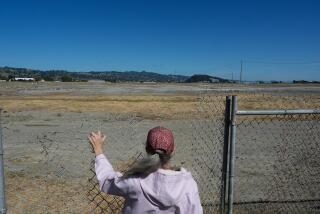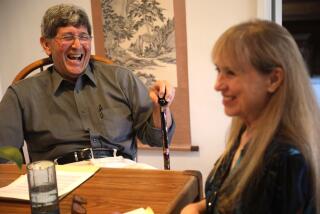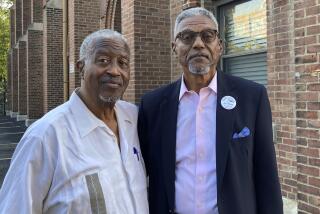Fallout Study Predicts Higher Cancer Incidence
- Share via
As many as 75,000 people exposed to iodine-131 in fallout from above-ground nuclear bomb tests in the 1950s could develop thyroid cancer as a result, according to data released Friday by the National Cancer Institute.
At highest risk are people who were children during the 1950s and who drank milk contaminated with the radioactive iodine.
Virtually everyone living in the United States during that period was exposed to some fallout, but 25 counties in Montana, Utah, Idaho, Colorado and South Dakota received enough to be considered hot spots, according to the report. Dozens of other counties in the farm belt and parts of the Northwest also received above-normal levels of exposure.
The average for the entire country was 2 rads of exposure, the equivalent of five mammograms.
The projections arise from a long-awaited study, mandated by Congress in 1982, that tracked radiation exposure in every U.S. county between 1951 and 1958. Although the existence of such fallout has been widely assumed for years, the results, released Friday at a news conference in Washington, show that fallout was more widespread and intense than had been believed.
National Cancer Institute officials advised anyone who lived in the regions with the highest levels of exposure during the 1950s to get a thyroid check the next time they visit their physicians. Thyroid cancer is readily treatable and has a high cure rate if detected early.
Of the 95 million Americans who were under age 20 during the tests, about 500,000 would be expected to develop thyroid cancer from other causes. The 75,000 potential new cases would be in addition to that.
But Dr. Richard Klausner, director of the cancer institute, cautioned that the link between thyroid cancer and iodine-131 has not been firmly established and that the estimate is a worst-case scenario. The observed exposures could cause as few as 10,000 extra cases of thyroid cancer, he said.
“There is no data in humans that give an accurate measure of risk for a certain level of exposure,” Klausner said. “We do not have the data to conclude that there is a large risk [from the observed exposures], but we cannot rule it out.”
Dr. Stanley Feld of the University of Texas Southwestern Medical School, immediate past president of the American Assn. of Clinical Endocrinologists, noted that hundreds of thousands of Americans have received more than 10 rads of iodine-131 for treatment of Graves’ disease with no increased incidence of thyroid tumors. Because it collects in the thyroid, iodine-131, ironically, is used for diagnosing and treating many thyroid problems, including thyroid cancer.
The cancer institute will put all 100,000 pages of the study on the Internet at https://rex.nci.nih.gov by Oct. 1. County-by-county data and summaries of the report are now available at that site.
Critics have charged that the cancer institute has been intentionally delaying release of the report.
“It is a remarkable demonstration of either ineptitude or extraordinarily contrived efforts to withhold information,” said Senate Minority Leader Tom Daschle (D-S.D.).
But Klausner denied any attempt to withhold the information. “This study was incredibly complex,” he said. “Nothing like this has ever been done before. It took 10 years to generate the data. Since then, we have been analyzing the data [and] verifying it.”
An estimated 160 million curies of iodine-131, a huge amount, were released into the atmosphere during 90 explosions at the Nevada Test Site. Although other isotopes were also dispersed, iodine-131 gets concentrated, first when cows eat grass coated with it and concentrate the iodine in milk, then when children drink the milk and concentrate the iodine in their thyroids.
A team headed by radiation epidemiologists Bruce Wachholz and Andre Bouville of the cancer institute examined weather patterns for the entire United States after each of the 90 tests to determine where iodine-131 would have been deposited. They also studied grazing patterns of cows and milk distribution patterns to estimate average exposure in each of the country’s 3,100 counties for each sex and for 13 age groups.
The team concluded that the average cumulative exposure for the 160 million people in the United States at that time was 2 rads. By comparison, a routine iodine-131 diagnostic thyroid scan--used to test for goiter, for example--of a child in the 1950s gave between 200 and 300 rads of exposure.
Although the average was 2 rads, exposures varied widely, from virtually zero in California and other parts of the Southwest to as much as 16 rads in the most severely affected counties. Because their thyroids are smaller and they drink more milk, children could get more than 100 rads.
The significance of the exposures remains a subject of debate. Although radiation from X-rays and other outside sources in high enough doses can cause thyroid cancer, the effects of ingesting iodine-131 have received only limited study.
Results obtained in Belarus and Ukraine after the 1986 Chernobyl nuclear reactor accident show that high exposures to iodine-131 definitely cause thyroid cancer. Other studies at lower levels, however, have shown only a tenuous link.
(BEGIN TEXT OF INFOBOX / INFOGRAPHIC)
Fallout Exposure Patterns
A study tracking radiation exposure from above-ground nuclear bomb tests between 1951 and 1958 found that virtually everyone living in the United States at that time was exposed to some fallout. The National Cancer Institute report identified 25 counties in Montana, Utah, Idaho, Colorado and South Dakota as particular hot spots. Dozens of counties in the farm belt also received above-normal levels of exposure to iodine-131.
Source: National Cancer Institute
Thyroid cancer
For a thyroid “neck check” all you need is a glass of water and a hand-held mirror.
1. Hold the mirror in your hand, focusing on the area of your neck just below the Adam’s apple and immediately above the collarbone.
2. While focusing on this area in the mirror, tip your head back. Take a drink of water and swallow.
3. Watch for any bulges or a protrusion in this area when you swallow. Reminder: Don’t confuse the Adam’s apple with the thyroid gland. The thyroid gland is located farther down on your neck, closer to the collarbone. You may want to repeat this process several times.
4. If you do see any bulges or protrusions in this area, see your physician immediately. You may have an enlarged thyroid gland or a thyroid nodule and should be checked to determine whether cancer is present or if treatment for thyroid disease is needed.
Source: Associated Press
More to Read
Sign up for Essential California
The most important California stories and recommendations in your inbox every morning.
You may occasionally receive promotional content from the Los Angeles Times.










